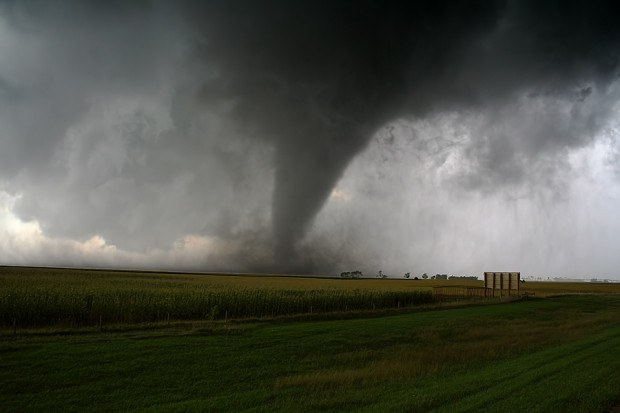The tornado outbreak that occurred on Nov. 17 could become the insurance industry’s first billion-dollar severe weather event to occur in November, according to RMS.
The catastrophe modeling firm reported the prediction of Matthew Nielsen, RMS director and meteorologist, in a media statement on Tuesday.
Nielsen said that Sunday’s outbreak is another anomalous occurrence of the unusual 2013 severe weather season, with the top three outbreaks this year occurring outside the usual spring/summer peak period. Instead, they occurred in 2013 in November (81, based on preliminary reports), January (62), and October (42).
Noting that a tornado preliminarily rated as an EF-4 impacted New Minden, Ill., east of St. Louis, Mo., in Sunday’s event, RMS said that this tornado was one of only 20 EF-4 tornadoes to occur in November since 1950, and the third most northerly November EF-4 ever observed, according to the Tornado History Project.
Pointing out other unusual characteristics of 2013 weather events, RMS noted that:
- Before Sunday, only 818 tornadoes had been confirmed this year (citing information from the wunderground blog of meteorologist Jeff Masters)—the lowest year-to-date count since 1988, according to Nielsen.
- This year’s events have been particularly damaging, with Aon Benfield reporting that there have been five severe-weather outbreaks that have caused at least $1 billion in damages this year (in Aon Benfield’s October 2013 Global Catastrophe Recap Report). This is the third highest total in U.S. recorded history behind the 2011 and 2012 seasons.
- The most expensive and deadliest outbreak was the May 18-22 event, driven mostly by the EF-5 tornado that devastated Moore, OK.
RMS said Sunday’s storm outbreak will likely rank as one of the top five most significant November outbreaks since 1950.
While late-season outbreaks are not uncommon, they are much more infrequent than the spring/summer outbreaks, RMS said, noting that since 1950, about 35 tornadoes per month have occurred in November, compared to nearly 200 per month in May.
The largest previous November tornado outbreak occurred from Nov. 21-23, 1992, where 95 tornadoes formed from Texas to Mississippi and into the Ohio Valley.
Sunday’s event is unique in how far north the severe weather extended, with severe thunderstorm and tornado warnings stretching into parts of Wisconsin and Michigan.
According to RMS, the severity of the outbreak was driven by two factors: unseasonably strong thermodynamic instability and unusually strong wind shear throughout the depth of the atmosphere.
Unlike spring and summer storms that require strong daytime heating to develop, with that type of heating rarely occurring in November, severe storms rely on strong upper-level winds and sharp temperature contrasts to give way to severe weather.
Storm Summary
Summarizing the Nov. 17-18, 2013 outbreak, RMS said there are 81 preliminary tornado reports (listed on NOAA’s website). Most occurred in Illinois and Indiana.
There were also 500 high wind reports, 17 of which were hurricane strength.
Six people have died, with dozens of others injured, as the region begins assessing the widespread damage.
- In Illinois, tornado touchdowns have been confirmed by the National Weather Service in Vermilion, Champaign, Tazewell, Woodford, Peoria, Massac and Iroquois counties. Damage has also been reported from severe weather in LaSalle, Wayne, Grundy and Washington counties.
- In Indiana, affected counties include: Vermillion, Fountain, Newton, Tippecanoe, Knox, Pulaski, Clinton, Howard, Cass, Daviess, Carroll, Miami, Martin, Tipton, and Boone.
- According to Indiana’s governor, 12 counties have reported widespread storm damage and several people have been injured. The town of Kokomo in Howard County, Indiana has declared a state of emergency through Monday morning local time and schools are to remain closed throughout the day.
- In Kentucky, affected counties include Butler, McCracken, Union, Lyon, Henderson, Hopkins, Muhlenberg, and Christian.
- In Missouri, affected counties include St. Louis, and St. Charles, and in Wisconsin, Dodge County appears at this time to be the only affected county.
The worst affected state appears to be Illinois where tornadoes and powerful thunderstorms have flattened entire neighborhoods, uprooted trees and damaged power lines. Significant tornado damage has been reported in the rural community of Washington in Tazewell County (population of roughly 16,000), located around 120 miles (190 km) southwest of Chicago.
Preliminary reports indicate that rows of homes were flattened, though official numbers of damaged buildings has not yet come to light, RMS said.
Preliminary NWS damage surveys have revealed EF-2 tornado damage near Coal City (population near 6,000) Grundy County, Ill., although the full extent of the damage is still to be assessed.
Source: RMS





















 Why ‘Good Enough’ Is Killing Insurance: The Hidden Cost of Satisficing
Why ‘Good Enough’ Is Killing Insurance: The Hidden Cost of Satisficing  Why the Middle Market Matters and How Insurers Can Capture It
Why the Middle Market Matters and How Insurers Can Capture It  Slideshow: Carrier Management’s 2025 Top Editor’s Picks (Unlocked)
Slideshow: Carrier Management’s 2025 Top Editor’s Picks (Unlocked)  Five AI Trends Reshaping Insurance in 2026
Five AI Trends Reshaping Insurance in 2026 





